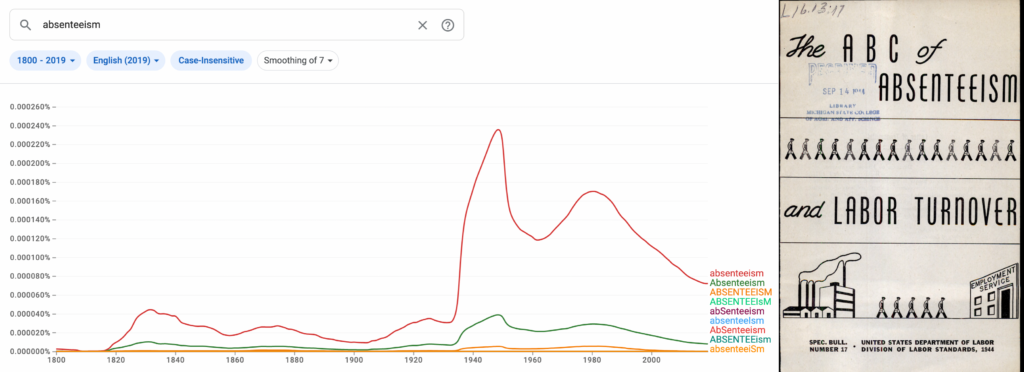Absenteeism
Absenteeism is currently a top 3 buzzword in conversations about the phenomena of modern day employees. The other two are:
- Presenteeism – where people show up to work at a reduced capacity when they perhaps shouldn’t, for example if they’re unwell
- Quiet quitting – where people show up, but do no more than the minimum required at their job, often in protest over pay or working conditions
What is absenteeism?
Absenteeism at work is where people don’t show up at all. It describes low attendance, particularly without “good” reason. How absenteeism is defined is typically dependent on who’s defining it. Legal sites like this one can be pretty cut and dry about it:
“Absenteeism is the term generally used to refer to unscheduled employee absences from the workplace. Many causes of absenteeism are legitimate—personal illness or family issues, for example—but absenteeism can also be traced to factors such as a poor work environment or workers who lack commitment to their jobs. If such absences become excessive, they can adversely impact the operations and, ultimately, the profitability of a business.”
Whereas sources with a healthcare focus, like the CDC (Centers for Disease Control and Prevention in the United States), have a more holistic definition:
“Workplace absenteeism refers to time taken off work due to illness or other reasons, such as childcare or transportation issues. Studying patterns of workplace absences can be useful for public health.”
I must admit, I thought absenteeism was a relatively new term. I don’t recall hearing or reading it as much pre-pandemic as I do now, so I looked it up:

Turns out the term “absenteeism” actually peaked in popularity during the forties, when books like The ABC of Absenteeism and Labor Turnover were being published, which says:
“Absenteeism and labor turnover rates are a kind of industrial barometer. When high in any given plant, they are storm signals pointing to unrest, serious production delays, and increased costs.”
In many ways, not a lot has changed in 80 years. Absenteeism does still lead to unrest, delays, and additional costs. It’s estimated the cost of absenteeism, presenteeism, and turnover increased 25% from 2019, reaching £53–56 billion in 2020–21.
A lot of the literature focuses on costs. A lot of the research goes into detail about the negative consequences to business, when and how you should discipline guilty employees. But that’s just one way of framing it. It’s important to consider the causes of absenteeism, as well as the effects. One review of various literature on the subject sums it up like this:
“Absenteeism is one of the clearest demonstrations of the relationship between health and work.”
“Both absenteeism and presenteeism could be due to temporary health conditions, such as the flu. However, more severe or long-lasting conditions could lead to persistent absences over time…”
Absenteeism post COVID
The reason I mention all this history with absenteeism is a) because it’s been a concern for businesses for a long time, and b) to emphasise how much all of the reading and research is now, arguably, in need of an update in light of how much the working world has changed since COVID.
For one, we’ve had new “temporary and long lasting health conditions” to deal with in the forms of coronavirus and long Covid.
We have an advanced and more holistic understanding of wellbeing in the workplace now, meaning we can look at absenteeism beyond “SICK? NO WORK! NO SICK? WORK!”
And you might have secretly always suspected this one but it turns out the length of the working day has increased—the National Bureau of Economic Research has it as an 8.2% increase, or an extra 48.5 minutes of work each day, whereas Bloomberg have data to suggest the working day has increased by 2.5 hours. Either way, there’s physically more work now to be absent from.
I think I’m seeing and hearing more about absenteeism because it’s simply harder to ignore.
What causes absenteeism?
I often put big important questions to one of two Coaching Practice Leads at Sanctus. Recently I’ve spoken to Valentina about impostorism, and Albert about career progression. This is, save for a few ums and ahs, word for word the voice note I received from Albert in response to this question this morning:
“In my experience, often the reason people stay away from work for longer periods than they should (or for unknown reasons) tends to be because they have specific personal demands in their life that they don’t feel comfortable sharing.”
“Whether it’s taking care of a sick parent or dealing with a mental health issue, it’s often something they feel in some ways ashamed of or embarrassed about to ask for special treatment. They end up going under the radar because they believe if they share the reasons they need time off or certain concessions, they will be reprimanded, stigmatised, potentially even penalised in some way.”
“This is where it gets tricky. Organisations need to have a contract around what we expect employees to deliver. But what isn’t stipulated in contracts often—because we want to treat people equally—is that different people have different demands. A single parent raising their kids alongside the demands of a full-time job has a very different capacity than a single person with no kids.”
“The good news is: most organisations at least try to treat all employees equally. Unfortunately because of that, those who have more challenges or demands in their lives tend to be seen as under performing, or that they’re not good enough. They get penalised or reprimanded, which is why then they end up hiding their challenges and trying to find other ways around it.”
Back in 2013, Forbes featured the following things as common causes of absenteeism:
- Bullying and harassment at work
- Burnout, stress, and low morale
- Care responsibilities (children, relatives)
- Depression
- Disengagement
- Illness and injury
- Interviewing elsewhere
- Arriving late, leaving early, taking longer breaks
I would argue that all of these factors have changed in some way or been impacted significantly over the last few years. Burnout and disengagement was exacerbated by the pandemic, and depression by lockdown. Anyone with a care responsibility was either at work or on edge 24/7. Illness increased. The great resignation saw people engineering career moves as they re-evaluated their worth alongside new priorities.
If the last few years have had an effect on the common causes of absenteeism, it makes sense that instances of absenteeism have increased. Back to Albert:
“The other obvious common one is job satisfaction and culture. Some job descriptions are very menial, they might be quite mundane and unstimulating, so the employee loses interest. Or there might be no clear promotional track at work, or there’s no job satisfaction, or no good relational dynamics at work.”
“People disengage when they don’t have connection or a sense of purpose at work.”
“From the organisation’s side, they appear to maybe be lazy or taking chances. But if they were more stimulated and engaged, they wouldn’t necessarily want to stay away from work. The challenge is that we don’t always know why people stay away from work. But we may not always be creating cultures where people feel safe to share their challenges.
“It could be a lack of interest in the role. It could be that the team is isolated. It could be any number of different personal challenges. In order to understand how people are actually doing, what keeps them engaged and what makes them feel disengaged from their work, we first need people to feel safe enough to voice their concerns.”
Addressing absenteeism
Some causes are incumbent on management to fix, like bullying and harassment at work, disengagement, and low morale. Some are entirely in the employee’s hands, and some require work on both sides.
Businesses have tried “performance pay”—where salary progression is linked to performance—in order to combat absenteeism, but studies suggest this isn’t the silver bullet many were hoping for:
“…the well-known productivity enhancements from performance pay are dampened by exhaustion-induced absenteeism stemming from additional working hours and higher per-hour work intensity.”
Leadership plays a key roles in addressing absenteeism. One study found different aspects of leadership affect employee absences differently. Leadership styles, attitudes, behaviours, social modelling, how they manage health and absences generally—themselves as well as in their teams. We’ve developed a five pillar approach to leadership development which, one way or another, covers each of these areas.
One research paper stresses the importance of social relationships in addressing absenteeism. Managers can plan better targeted interventions with people who may be at risk of absenteeism, if they have a better understanding of how employees see and interact with various organisational relationships in the workplace. The same paper recommends managers focus on the following:
- Creating a strong connection to the workplace among employees
- Generating a common understanding between employees and management about how to perform tasks at work
- Ensuring employees are involved in managerial decisions
We’ve written a guide on how to do all of that (and a lot more), including the importance of building a working culture built around people, and the spirit of community, belonging, communication, and trust. Because it seems loneliness is also a key factor in absenteeism.
Study findings show lonely workers experience far greater stress-related absenteeism, and subsequently a greater likelihood of leaving the business, than workers who aren’t lonely. Proactively addressing loneliness and facilitating personal and professional development is seen as an effective employee engagement and retention strategy.
Case study: using coaching to address absenteeism
Can Coaching Reduce the Incidence of Stress-Related Absenteeism?
“The results showed that the respondents felt an increase in social support from their colleagues, superiors and family. This support was documented to have a significant effect on reducing their stress levels…”
- 72% said that through coaching, they have learned to prioritize their time better
- 79% said that they feel better equipped to make decisions based on what is truly important to them
- 81% said that through coaching, they have gained a deeper understanding for the thoughts and actions that stand in their way
- 85% said that the coaching has made a significant impact on them and has helped them make various necessary changes in their day-to-day lives
- 74% said that coaching has provided them with tools and perspectives that help them tackle stress better
“These results by themselves do not give an absolute answer to the question proposed above, but do help illustrate the issues related to the incidences of insufficient leadership and a fast pace in the workplace draining employees on all levels of an organization…”
How does coaching help with absenteeism?
Businesses need to approach absenteeism with the positive assumption that people have “good”, legitimate reasons for missing work, rather than assuming people are taking chances or trying to abuse the system. If managers are regularly interrogating employees about why they aren’t showing up or why they’re taking so many sick days, it’s more likely they’ll be defensive and less likely you’ll get an accurate answer you can work with.
Sanctus Coaching gives employees a space—which is still part of work, but separate—where they can have an honest conversation with a neutral party about whatever is on their mind. Things they can’t or won’t speak to their manager about, but could really benefit from having a professional coach to talk it out with.
Coaching can be used to talk about feelings, process thoughts, and investigate the root causes of certain professional and personal issues. People use coaching for lots of different reasons, but planning difficult conversations, identifying and implementing healthier habits, and working out what you need to improve your life are just a few that could be relevant to anyone at risk of, or experiencing absenteeism.
At the end of the day, coaching can’t look after the kids, but it can help parents find balance, facilitate the transition back into work, and increase their organisation skills, resilience, and general self-confidence.
Coaching won’t heal an injury or cure a disease overnight, but it can help you get more in touch with your body as well as your mind, make the most out of the recovery process, and develop a focus for returning to fitness stronger and with improved readiness.
Sanctus coaches are highly trained and accredited, and welcome everyone who comes through their door. They see people as the full sum of their parts, not just any one thing or condition.

